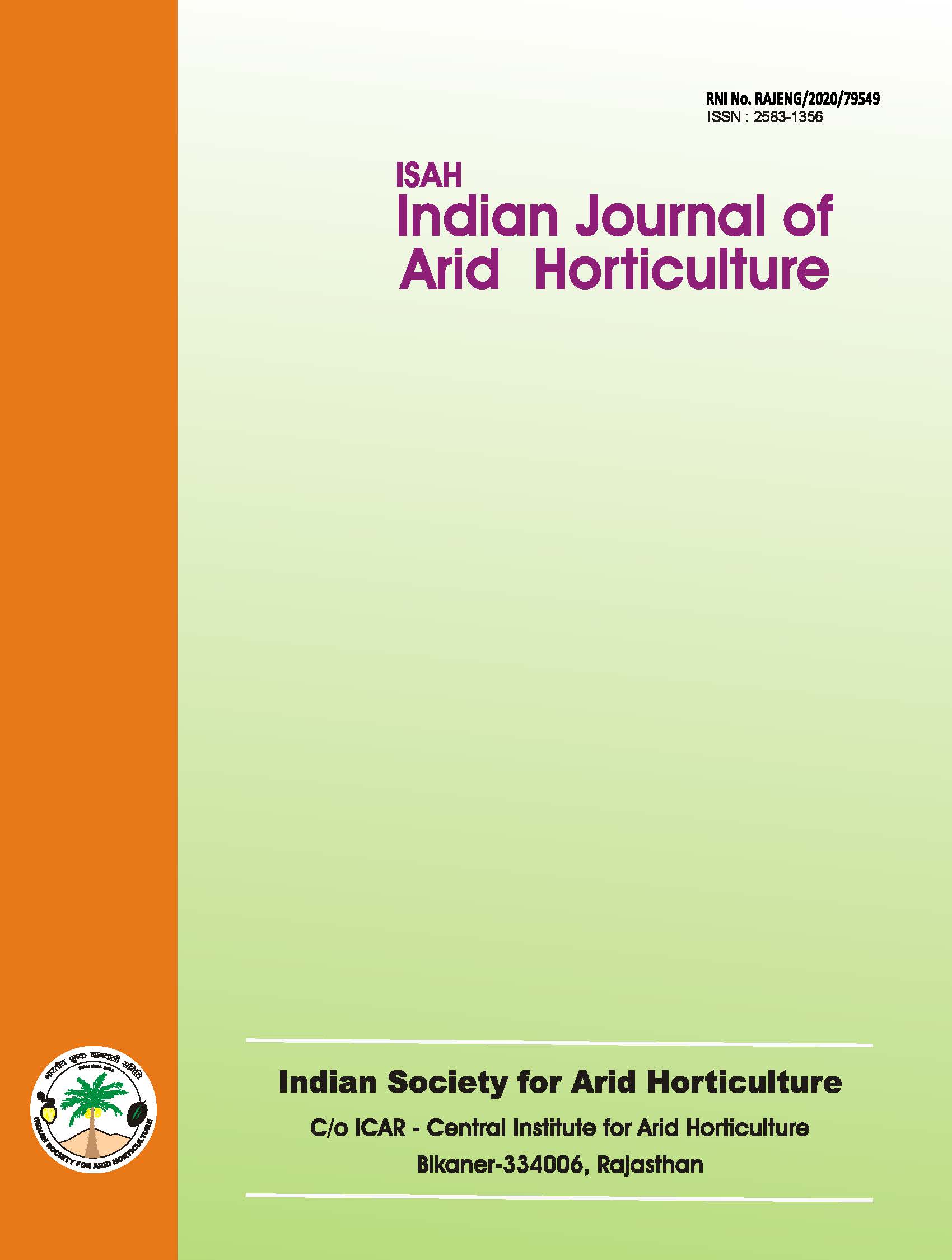Influence of organic and inorganic source of nutrients on physico-chemical attributes of fig (Ficus carica L.) cv. Dinkar
DOI:
https://doi.org/10.48165/ijah.2024.6.1.6Keywords:
Physico-chemical attri butes, inorganic nutrients, organic manures, fig, DinkarAbstract
A field experiment was conducted during 2023-24 to evaluate the impact of organic and inorganic nutrients on the physico-chemical attributes of fig cv. Dinkar. The highest fruit size, including length (5.31 cm), width (5.42 cm), fresh fruit weight (44.38 g), dry fruit weight (21.48 g), fruit volume (45.70 cc), and specific gravity (0.970), were observed in plants applied with 75% NPK + 25% Poultry manure. Additionally, the highest values for TSS (18.86° Brix), reducing sugars (17.60%), non-reducing sugars (1.29%), total sugar (18.90%), and TSS/Acid ratio (93.21) were also recorded with 75% NPK + 25% Poultry manure. The lowest acidity (0.24%) was found in plants treated with 75% NPK + 25% Poultry manure, while the highest acidity (0.24%) was noted in those treated with 75% NPK + 25% Vermicompost. The highest ascorbic acid content (13.30 mg/100g pulp) was also observed in the 75% NPK + 25% Poultry manure treatment.
Downloads
References
Crisosto, C.H., Ferguson, L., Bremer, V., Stover, E., Colelli, G. 2011. Fig (Ficus carica L.). In: Yahia, E.E. (Ed.), Postharvest Biolo gy and Technology of Tropical and Subtropical Fruits. Fruits, 3. Cocona to Mango. Woodhead Publishing Ltd., Cambridge, UK, pp. 134–158.
Ennab, H. 2016. Effect of Organic Manures, Biofertilizers and NPK on vegetative growth, yield, fruit quality and soil fertility of Eureka Lemon Trees (Citrus limon (L.) Burm). Journal of Soil Sciences and Agricultural Engineering, 7(10): 767-774.
Flaishman, M.A., Rodov, V. and Stover, E. 2008. The Fig: Botany, horticulture and breeding. Hortic. Rev., 34: 113–197. Gawande, S.S., Jiotode, D.J., Turkhede, A.B. and Darange, S.O. 1998. Effect of organic and inorganic fertilizers on yield and quality of sapota. Journal of Soil and Crops, 8(1): 58-60. Goswami, A.K., Lal, S., Thakare, M. and Kumar, R. 2015. Studies on integrated nutrient management on yield and quality of guava cv. Pant Prabhat. Indian Journal of Horticulture, 72(1):139-142. Hazarika, T.K. and Aheibam, B. 2019. Soil nutrient status, yield and quality of lemon (Citrus limon Burm.) cv. ‘Assam lemon’s influenced by bio-fertilizers, organic and inorganic fertiliz ers. Journal of Plant Nutrition, 42(8): 853-863.
Kjellberg, F., Gouyon, P.H., Ibrahim, M., Raymond, M. and Valdey ron, V. 1987. The stability of the symbiosis between dioecious figs and their pollinators: a study of Ficus carica L. and Blasto phaga psenes L. Evolution, 41: 704–963.
Kumar, S.P., Singh, C., Verma, A.K. and Jain, B.P. 1998. Effect of potassium, nitrogen, zinc and gibberellic acid on yield attri butes of guava (Psidium guajava L.). Journal of Research, Birsa Agriculture University, 10(1): 52-55.
Kurubar, A.R., Allolli, T.B., Naik, M.K. and Angadi, S.G. 2015. Ef fect of organic and inorganic fertilizers on fruit characters, quality and economics of fig production (Ficus carica L.). In: V International Symposium on Fig. 1173: pp. 213-216.
Manjunatha Hebbara, M.H., Ganiger, V.M., Reddy, B.G.M. and Joshi, V.R. 2006. Integrated nutrient management in sapota (Manilkara zapota) using vermicompost to increase yield and quality. Indian Journal of Agricultural Sciences, 76(1): 587-590.
Mishra, S. and Bahadur, V. 2019. Effect of chemical fertilizers, bio-fertilizers and organic manure on growth, yield and quali ty of guava under Prayagraj agro-climatic condition. Journal of Pharmacognosy and Phytochemistry, 8(4): 3154-3158.
Pereira, L.S. and Mitra, S.B.L., 1999. Studies on organic along with inorganic nutrition in guava. Indian Agric., 43 (3-4): 155-160. Sharma A., Wali V K., Bakshi P. and Jasrotia, A. 2013. Effect of Organic and Inorganic Fertilizers on Quality and Shelf Life of Guava (Psidium guajava L.) Cv. Sardar. The Bioscan, 8(4): 1247-1250.
Sharma, A., Wali, V.K., Bakshi, P. and Jasrotia, A. 2013. Effect of integrated nutrient management strategies on nutrient sta-
tus, yield and quality of guava. Indian Journal of Horticul ture, 70(3): 333-339.
Shukla, S.K., Adak, T., Singha, A., Kumar, K., Singh, V.K. and Singh, A. 2014. Response of guava trees (Psidium guajava) to soil ap plications of mineral and organic fertilisers and biofertilisers under conditions of low fertile soil. Journal of Horticultural Research, 22(2): 105-114.
Singh, L. and Sadawarti, R.K. 2021. Effect of INM (Integrated nutrient management) on plant growth, yield and quality of strawberry (Fragaria ananassa Duch.). The Pharma Innova tion Journal, 10: 244-47.
Singh, S. R. and Banik, B. C. 2011. Response of integrated nutrient management on flowering, fruit setting, yield and fruit quality in sweet orange (Citrus sinensis). Asian Journal of Horticulture, 6(1): 151- 154.
Solomon, A., Golubowicz, S., Yablowic, Z., Grossman, S., Berg man, M., Gottlieb, H.G., Altman, A., Kerem, Z. and Flaish man, M.A. 2006. Antioxidant activities and anthocyanin con tent of fresh fruits of common fig (Ficus carica L.), J. Agric.
Food Chem., 54: 7717−7723.
Vinson, J.A. 1999. The functional food properties of figs. Cereal Foods World, 44(2): 82-87.
Vinson, J.A., Zubik, L., Bose, P., Samman, N. and Proch, J. 2005. Dried fruits: excellent in vitro and in vivo antioxidants. Jour nal of the American College of Nutrition, 24(1): 44-50.
Vitamin and mineral recommendations; http://www.nal.usda.gov/ fnic/etext/000105.html#q2
Weibin, J., Kai, M., Zhifeng, L., Yelin, W. and Lianju, W. 2001. The production and research of fig (Ficus carica L.) in China. In II International Symposium on Fig. 605: pp. 191-196.

